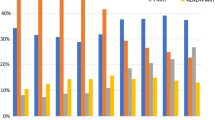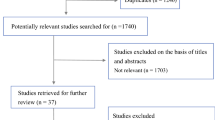Abstract
Background
Management of axillary disease in breast cancer has evolved significantly over the last two decades with the introduction of SLNB and a trend towards less radical surgery. Data from the American College of Surgeons Oncology Group Z0011 trial proposes that not all patients with positive axillary lymph nodes require completion axillary dissection.
Aims
The aim of this study was to determine whether there has been a change in practice patterns for axillary management in Ireland since the publication of this ‘practice-changing’ trial.
Methods
A review of breast cancers managed in the 12 months prior to publication of Z0011 (pre-Z0011) and comparison with those managed in the following 12 months (post-Z0011) was undertaken in three tertiary referral breast cancer centres. Patients with a positive SLNB were identified, and clinicopathologic data and subsequent management was compared between the two cohorts.
Results
There were 708 SLNB performed during the study period; 326 pre-Z0011 and 382 post-Z0011. There was no difference in the rate of SLN positivity between the two cohorts: 29.1 % had a positive SLN pre-Z0011 and 29.3 % were positive post-Z0011. There were a significantly lower number of axillary clearances performed in SLN-positive patients in the post-Z0011 period (71.4 %) compared to the pre-Z011 period (93.7 %, p = 0.0022 Chi-square). Of the patients with tumour characteristics meeting the Z0011 inclusion criteria in the initial 12 months of the study, 92.3 % underwent ALND compared with 65.6 % in the final 12 months of the study (p = 0.0006 Chi-square).
Conclusions
There has been a change in clinical practice since the publication of the Z0011 trial, illustrated by a decrease in the rate of axillary clearance in node-positive breast cancers.
Similar content being viewed by others
References
Krag DN, Anderson SJ, Julian TB et al (2007) Technical outcomes of sentinel-lymph-node resection and conventional axillary-lymph-node dissection in patients with clinically node-negative breast cancer: results from the NSABP B-32 randomised phase III trial. Lancet Oncol 8:881–888
Veronesi U, Paganelli G, Viale G et al (2003) A randomized comparison of sentinel-node biopsy with routine axillary dissection in breast cancer. N Engl J Med 349:546–553
Fleissig A, Fallowfield LJ, Langridge CI et al (2006) Post-operative arm morbidity and quality of life: results of the ALMANAC randomised trial comparing sentinel node biopsy with standard axillary treatment in the management of patients with early breast cancer. Breast Cancer Res Treat 95:279–293
Lucci A, McCall LM, Beitsch PD et al (2007) Surgical complications associated with sentinel lymph node dissection (SLND) plus axillary lymph node dissection compared with SLND alone in the American College of Surgeons Oncology Group Trial Z0011. J Clin Oncol 25:3657–3663
Cyr A, Gillanders WE, Aft RL et al (2010) Micrometastatic disease and isolated tumor cells as a predictor for additional breast cancer axillary metastatic burden. Ann Surg Oncol 17(Suppl. 3):S303–S311
Cox CE, Kiluk VJ, Riker AI et al (2008) Significance of sentinel lymph node micrometastases in human breast cancer. J Am Coll Surg 206:261–268
Reed J, Rosman M, Verbanac KM et al (2009) Prognostic implications of isolated tumor cells and micrometastases in sentinel nodes of patients with invasive breast cancer: 10-year analysis of patients enrolled in the prospective East Carolina University/Anne Arundel Medical Center sentinel node multicenter study. J Am Coll Surg 208:333–340
De Boer M, van Deurzen C, van Dijck J et al (2009) Micrometastases or isolated tumor cells and the outcome of breast cancer. N Engl J Med 361:653–663
Truong PT, Vinh-Hung V, Cserni G et al (2008) The number of positive nodes and the ratio of positive to excised nodes are significant predictors of survival in women with micrometastatic node-positive breast cancer. Eur J Cancer 44:1670–1677
Colleoni M, Rotmensz N, Peruzzotti G et al (2005) Size of breast cancer metastases in axillary lymph nodes: clinical relevance of minimal lymph node involvement. J Clin Oncol 23:1379–1389
Joyce DP, Solon JG, Prichard RS et al (2012) Is there a requirement for axillary lymph node dissection following identification of micro-metastasis or isolated tumour cells at sentinel node biopsy for breast cancer? Surgeon 10(6):326–329
Giuliano AE, McCall L, Beitsch P et al (2010) Locoregional recurrence after sentinel lymph node dissection with or without axillary dissection in patients with sentinel lymph node metastases: the American College of Surgeons Oncology Group Z0011 randomized trial. Ann Surg 252(3):426–432
Giuliano AE, Hunt KK, Ballman KV et al (2011) Axillary dissection vs no axillary dissection in women with invasive breast cancer and sentinel node metastasis: a randomized clinical trial. JAMA 305(6):569–575
Caudle AS, Hunt KK, Tucker SL et al (2012) American College of Surgeons Oncology Group (ACOSOG) Z0011: impact on surgeon practice patterns. Ann Surg Oncol 19(10):3144–3151
Giuliano AE, Kirgan DM, Guenther JM et al (1994) Lymphatic mapping and sentinel lymphadenectomy for breast cancer. Ann Surg 220(3):391–401
Giuliano AE, Morrow M, Duggal S et al (2012) Should ACOSOG Z0011 change practice with respect to axillary lymph node dissection for a positive sentinel lymph node biopsy in breast cancer? Clin Exp Metastasis 29(7):687–692
Fisher B, Jeong JH, Anderson S et al (2002) Twenty-five-year follow-up of a randomized trial comparing radical mastectomy, total mastectomy, and total mastectomy followed by irradiation. N Engl J Med 347(8):567–575
Giuliano AE, Hawes D, Ballman KV et al (2011) Association of occult metastases in sentinel lymph nodes and bone marrow with survival among women with early-stage invasive breast cancer. JAMA 306:385–393
Rutgers EJ, Donker M, Straver ME et al. (2013) Radiotherapy or surgery of the axilla after a positive sentinel node in breast cancer patients: final analysis of the EORTC AMAROS trial. J Clin Oncol 31(suppl; abstr LBA 1001)
Caudle AS, Hunt KK, Kuerer HM et al (2011) Multidisciplinary considerations in the implementation of the findings from the American College of Surgeons Oncology Group (ACOSOG) Z0011 study: a practice-changing trial. Ann Surg Oncol 18:2407–2412
American Society of Clinical Oncology (ASCO). ASCO Perspective on JAMA breast cancer lymph node study findings. Available: http://www.racheldultz.com/ASCO.pdf
Güth U, Myrick ME, Viehl CT et al (2012) The post ACOSOG Z0011 era: does our new understanding of breast cancer really change clinical practice? Eur J Surg Oncol 38(8):645–650
Olsen S, Amr B, Omar A et al (2011) Are the findings of ACOSOG Z0011 applicable to district general hospital unit—and how should they change our practice. Cancer Res 71:355s–356s
Lannin D, Killilea B, Grube B et al (2011) How generalizable is the patient population enrolled in ACOSOG Z0011? Cancer Res 71:366s–367s
Chalmers C, Mallon E, Stallard S et al (2011) The potential impact of applying the Z0011 trial to our practice in the UK. Cancer Res 71:368s
Yeow W, Thomee E, Roche N et al (2011) ACOSOG Z0011: are the results applicable to patients undergoing sentinel node biopsy in a UK breast unit. Eur J Surg Oncol 37:S11–S12
Ainsworth RK, Kollias J, Blanc AL et al (2013) The clinical impact of the American College of Surgeons Oncology Group Z-0011 trial—results from the BreastSurgANZ National Breast Cancer Audit. Breast 22(5):733–735
Camp MS, Greenup RA, Taghian A et al (2013) Application of ACOSOG Z0011 criteria reduces perioperative costs. Ann Surg Oncol 20(3):836–841
http://www.nccn.org/professionals/physician_gls/pdf/breast.pdf
Conflict of interest
None.
Author information
Authors and Affiliations
Corresponding author
Rights and permissions
About this article
Cite this article
Joyce, D.P., Lowery, A.J., McGrath-Soo, L.B. et al. Management of the axilla: has Z0011 had an impact?. Ir J Med Sci 185, 145–149 (2016). https://doi.org/10.1007/s11845-015-1246-0
Received:
Accepted:
Published:
Issue Date:
DOI: https://doi.org/10.1007/s11845-015-1246-0




